| Listing 1 - 10 of 14 | << page >> |
Sort by
|
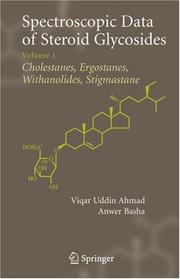
ISBN: 9780387395715 0387311599 9780387311593 0387395717 Year: 2007 Publisher: New York, NY : Springer New York : Imprint: Springer,
Abstract | Keywords | Export | Availability | Bookmark
 Loading...
Loading...Choose an application
- Reference Manager
- EndNote
- RefWorks (Direct export to RefWorks)
Spectroscopic Data of Steroid Glycosides Dr. Viqar Uddin Ahmad, HEJ Research Institute of Chemistry, University of Karachi, Karachi, Pakistan Dr. Anwer Basha, Abbott Laboratories , Abbott Park, Illinois, USA Spectroscopic Data of Steroid Glycosides serves as an essential reference guide containing spectroscopic, physical and biological activity data of over 3500 steroid glycosides, offering the structures and the data of the naturally occurring glycosides of steroids. All compounds are arranged according to the structure of the aglycone, and, in its own class, according to the increasing molecular weight, making Spectroscopic Data of Steroid Glycosides extremely useful for the structure elucidation of new natural products, particularly glycosides. Spectroscopic Data of Steroid Glycosides offers a practical desk reference for all scientists and students interested in steroid glycosides and their biological and medicinal importance. The following data of the steroid glycosides, as available in published literature, are included: Name of the compound Chemical name of compound and its structure Source, name of the genus, species, authors, family of the biological source from which the glycoside has been isolated. Melting point Specific rotation Molecule weight Molecular formula UV spectral data : maxima, e or log e , solvent IR peaks in cm-1 with medium in which the spectrum was taken e.g. KBr, nujol, etc Proton magnetic resonance (PMR) chemical shifts, multiplicity of the peaks, coupling constants with assignments 13C-NMR (CMR) chemical shifts with assignments Mass spectral data with the technique used (e.g. Electron Impact (E.I.), Fast Atom Bombardment (FAB), positive ion or negative ion mode or any other technique CD or ORD data Biological Activity Full reference from which data have been taken.
Life Sciences. --- Plant Biochemistry. --- Pharmacology/Toxicology. --- Medical Biochemistry. --- Biochemistry, general. --- Life sciences. --- Toxicology. --- Biochemistry. --- Sciences de la vie --- Toxicologie --- Biochimie --- Glycosides -- Chemistry. --- Molecular Structure. --- Spectrum analysis. --- Steroid glycosides. --- Steroids -- Chemistry. --- Plant Physiology --- Animal Biochemistry --- Botany --- Human Anatomy & Physiology --- Health & Biological Sciences --- Earth & Environmental Sciences --- Pharmacology. --- Medical biochemistry. --- Plant biochemistry. --- Phytochemistry --- Plant biochemistry --- Plant chemistry --- Biochemistry --- Phytochemicals --- Plant biochemical genetics --- Biological chemistry --- Chemical composition of organisms --- Organisms --- Physiological chemistry --- Biology --- Chemistry --- Medical sciences --- Medical biochemistry --- Pathobiochemistry --- Pathological biochemistry --- Pathology --- Drug effects --- Medical pharmacology --- Chemicals --- Chemotherapy --- Drugs --- Pharmacy --- Biosciences --- Sciences, Life --- Science --- Composition --- Physiological effect --- Medicine --- Pharmacology --- Poisoning --- Poisons --- Toxicology
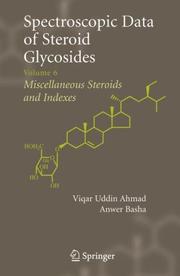
ISBN: 9780387395807 0387311653 9780387311654 1441921710 0387395806 Year: 2006 Publisher: New York, NY : Springer New York : Imprint: Springer,
Abstract | Keywords | Export | Availability | Bookmark
 Loading...
Loading...Choose an application
- Reference Manager
- EndNote
- RefWorks (Direct export to RefWorks)
Spectroscopic Data of Steroid Glycosides Dr. Viqar Uddin Ahmad, HEJ Research Institute of Chemistry, University of Karachi, Karachi, Pakistan Dr. Anwer Basha, Abbott Laboratories , Abbott Park, Illinois, USA Spectroscopic Data of Steroid Glycosides serves as an essential reference guide containing spectroscopic, physical and biological activity data of over 3500 steroid glycosides, offering the structures and the data of the naturally occurring glycosides of steroids. All compounds are arranged according to the structure of the aglycone, and, in its own class, according to the increasing molecular weight, making Spectroscopic Data of Steroid Glycosides extremely useful for the structure elucidation of new natural products, particularly glycosides. Spectroscopic Data of Steroid Glycosides offers a practical desk reference for all scientists and students interested in steroid glycosides and their biological and medicinal importance. The following data of the steroid glycosides, as available in published literature, are included: Name of the compound Chemical name of compound and its structure Source, name of the genus, species, authors, family of the biological source from which the glycoside has been isolated. Melting point Specific rotation Molecule weight Molecular formula UV spectral data : maxima, e or log e , solvent IR peaks in cm-1 with medium in which the spectrum was taken e.g. KBr, nujol, etc Proton magnetic resonance (PMR) chemical shifts, multiplicity of the peaks, coupling constants with assignments 13C-NMR (CMR) chemical shifts with assignments Mass spectral data with the technique used (e.g. Electron Impact (E.I.), Fast Atom Bombardment (FAB), positive ion or negative ion mode or any other technique CD or ORD data Biological Activity Full reference from which data have been taken.
Life Sciences. --- Plant Biochemistry. --- Pharmacology/Toxicology. --- Medical Biochemistry. --- Life sciences. --- Toxicology. --- Biochemistry. --- Sciences de la vie --- Toxicologie --- Biochimie --- Spectrum analysis. --- Steroid glycosides. --- Human Anatomy & Physiology --- Botany --- Animal Biochemistry --- Plant Physiology --- Earth & Environmental Sciences --- Health & Biological Sciences --- Analysis, Spectrum --- Spectra --- Spectrochemical analysis --- Spectrochemistry --- Spectroscopy --- Pharmacology. --- Medical biochemistry. --- Plant biochemistry. --- Chemistry, Analytic --- Interferometry --- Optics --- Radiation --- Wave-motion, Theory of --- Absorption spectra --- Light --- Spectroscope --- Glycosides --- Steroids --- Steroid saponins --- Qualitative --- Chemicals --- Medicine --- Pharmacology --- Poisoning --- Poisons --- Biological chemistry --- Chemical composition of organisms --- Organisms --- Physiological chemistry --- Biology --- Chemistry --- Medical sciences --- Toxicology --- Composition --- Drug effects --- Medical pharmacology --- Chemotherapy --- Drugs --- Pharmacy --- Phytochemistry --- Plant biochemistry --- Plant chemistry --- Biochemistry --- Phytochemicals --- Plant biochemical genetics --- Medical biochemistry --- Pathobiochemistry --- Pathological biochemistry --- Pathology --- Physiological effect
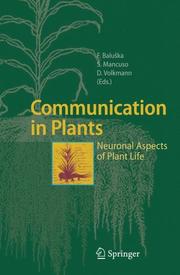
ISBN: 9783540285168 9783540284758 3540284753 3642066720 9786610608720 1280608722 3540285164 Year: 2006 Publisher: Berlin, Heidelberg : Springer Berlin Heidelberg : Imprint: Springer,
Abstract | Keywords | Export | Availability | Bookmark
 Loading...
Loading...Choose an application
- Reference Manager
- EndNote
- RefWorks (Direct export to RefWorks)
Plant neurobiology is a newly emerging field of plant sciences. It covers signalling and communication at all levels of biological organization – from molecules up to ecological communities. In this book, plants are presented as intelligent and social organisms with complex forms of communication and information processing. Authors from diverse backgrounds such as molecular and cellular biology, electrophysiology, as well as ecology treat the most important aspects of plant communication, including the plant immune system, abilities of plants to recognize self, signal transduction, receptors, plant neurotransmitters and plant neurophysiology. Further, plants are able to recognize the identity of herbivores and organize the defence responses accordingly. The similarities in animal and plant neuronal/immune systems are discussed too. All these hidden aspects of plant life and behaviour will stimulate further intense investigations in order to understand the communicative plants in their whole complexity.
Histologie. Cytologie --- Fysiologie en biofysica der planten --- Neurofysiologie. Zintuigfysiologie --- Industriële biochemie --- systematische plantkunde --- biochemie --- cytologie --- histologie --- planten --- neurobiologie --- Plant cellular signal transduction --- Plant physiology --- Plant physiology. --- Cytology. --- Biochemistry. --- Botany. --- Neurobiology. --- Plant Physiology. --- Cell Biology. --- Plant Biochemistry. --- Plant Sciences. --- Neurosciences --- Botany --- Plants --- Physiology --- Botanical science --- Phytobiology --- Phytography --- Phytology --- Plant biology --- Plant science --- Biology --- Natural history --- Biological chemistry --- Chemical composition of organisms --- Organisms --- Physiological chemistry --- Chemistry --- Medical sciences --- Cell biology --- Cellular biology --- Cells --- Cytologists --- Composition --- Cell biology. --- Plant biochemistry. --- Plant science. --- Phytochemistry --- Plant biochemistry --- Plant chemistry --- Biochemistry --- Phytochemicals --- Plant biochemical genetics --- Floristic botany --- Acqui 2006
Book
ISBN: 9789048127528 9789048127511 Year: 2010 Volume: 45 Publisher: Dordrecht Springer Netherlands
Abstract | Keywords | Export | Availability | Bookmark
 Loading...
Loading...Choose an application
- Reference Manager
- EndNote
- RefWorks (Direct export to RefWorks)
Earlier works on plant essential elements have revealed a series of complicated, counter-intuitive relationships among various chemical elements in different plant species, due to both unlike usage of certain elements in plants and to different carriers effecting resorption and transport. In an attempt to provide a more coherent theory behind plant mineral nutrition, this groundbreaking book adopts a very different approach from the existing literature, presenting an explanation of the essentiality of chemical elements in biological systems and the application of stoichiometric network analysis (SNA) to the biological system of elements. Starting with data from biochemical environmental analysis, and a discussion of the phenomena involved in metal ion partition and autocatalytic behaviour, conditions and criteria controlling the partition of metals into biomass are investigated. Several rules are derived and investigated in terms of their interaction both in comparisons among contemporary organisms and in terms of evolution. This allows the construction, for example of a map which directly traces the biological feature of essentiality to parameters of coordination chemistry. The book will have worldwide appeal for researchers interested in fields such as soil/plant interactions, bioinorganic chemistry, plant nutrition, phytomining, bioremediation, biogeochemistry, nutrient cycling, soil chemistry, and cellular physiology.
Life Sciences. --- Plant Biochemistry. --- Analytical Chemistry. --- Inorganic Chemistry. --- Molecular Ecology. --- Environmental Monitoring/Analysis. --- Life sciences. --- Analytical biochemistry. --- Chemistry, inorganic. --- Biochemistry. --- Molecular ecology. --- Sciences de la vie --- Biochimie analytique --- Biochimie --- Écologie moléculaire
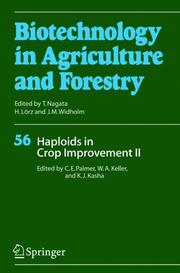
ISSN: 0934943X ISBN: 9783540268895 9783540222248 3540222243 3642060730 9786610427604 1280427604 3540268898 Year: 2005 Volume: 56 Publisher: Berlin, Heidelberg : Springer Berlin Heidelberg : Imprint: Springer,
Abstract | Keywords | Export | Availability | Bookmark
 Loading...
Loading...Choose an application
- Reference Manager
- EndNote
- RefWorks (Direct export to RefWorks)
Doubled haploid technology is an important tool for plant breeding. It allows for significant time reduction in the achievement of homozygous breeding lines of value in crop improvement. This volume provides an excellent overview of haploid induction and the application of doubled haploids. The authors emphasize advances made in the understanding of microspore embryogenesis, but treat also advances in gynogenesis and the manipulation of parthenogenetic haploid development. The text contains a thorough discussion of the application of haploidy to the improvement of a number of species from various families, including Brassicaceae, Poaceae, and Solanaceae. The various methods applicable to these species are described in detail. Each chapter contains critical evaluation of the scientific literature and an extensive list of references. This volume is ideally suited for plant breeders, geneticists, and plant cell biologists.
Biochemical engineering --- histologie --- biotechnologie --- biochemie --- Histology. Cytology --- Plant physiology. Plant biophysics --- Biotechnology --- systematische plantkunde --- landbouw --- planten --- Agriculture. Animal husbandry. Hunting. Fishery --- bioengineering --- cytologie --- Crop improvement --- Crops --- Haploidy --- Cultures --- Haploïdie --- Genetic engineering --- Amélioration --- Génie génétique --- Haploidy. --- Plant breeding. --- Plant genetic engineering. --- Life sciences. --- Biotechnology. --- Agriculture. --- Plant biochemistry. --- Cell biology. --- Plant science. --- Botany. --- Plant genetics. --- Life Sciences. --- Plant Sciences. --- Cell Biology. --- Plant Biochemistry. --- Plant Genetics & Genomics. --- Crop improvement. --- Genetic engineering. --- Haploids --- Chromosome numbers --- Genomes --- Plant genetic engineering --- Improvement, Crop --- Agriculture --- Improvement --- Cytology. --- Biochemistry. --- Plant Genetics and Genomics. --- Chemical engineering --- Plants --- Genetics --- Biological chemistry --- Chemical composition of organisms --- Organisms --- Physiological chemistry --- Biology --- Chemistry --- Medical sciences --- Cell biology --- Cellular biology --- Cells --- Cytologists --- Botanical science --- Phytobiology --- Phytography --- Phytology --- Plant biology --- Plant science --- Natural history --- Farming --- Husbandry --- Industrial arts --- Life sciences --- Food supply --- Land use, Rural --- Composition --- Phytochemistry --- Plant biochemistry --- Plant chemistry --- Biochemistry --- Botany --- Phytochemicals --- Plant biochemical genetics --- Floristic botany --- Botanical chemistry. --- Plant Science. --- Plant Genetics.
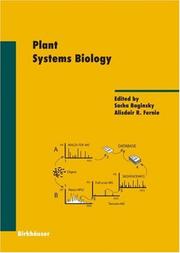
ISBN: 9783764374396 9783764372613 3764372613 9786610943746 1280943742 376437439X Year: 2007 Publisher: Basel : Birkhäuser Basel : Imprint: Birkhäuser,
Abstract | Keywords | Export | Availability | Bookmark
 Loading...
Loading...Choose an application
- Reference Manager
- EndNote
- RefWorks (Direct export to RefWorks)
Systems biology represents the integration and application of various technologies that share a common goal of measuring globally the properties of a specific biological sample. These combined data describe and monitor the complex networks that exist within each cell, tissue and organism, and can be used to generate predictive models of the behavior of the system. This volume aims to provide a timely view of the "state of the art" in systems biology. The editors take the opportunity to define systems biology as they and the contributing authors see it, and this will lay the groundwork for future studies. The volume is well-suited to both students and researchers interested in the methods of systems biology. Although the focus is on plant systems biology, the proposed material could be suitably applied to any organism.
proteomics --- Biochemical engineering --- Computer. Automation --- Genetics --- bio-engineering --- Biology --- informatica --- proteïnen --- biologie --- biochemie --- planten --- Plants --- Systems Biology --- Automatic Data Processing --- Plant molecular genetics --- Biological systems --- Génétique moléculaire végétale --- Data processing --- EPUB-LIV-FT SPRINGER-B LIVBIOLO --- Plant molecular biology. --- Systems biology. --- Plants. --- Systems Biology. --- Electronic Data Processing. --- Biochemistry. --- Biochemical engineering. --- Proteomics. --- Plant Biochemistry. --- Biochemical Engineering. --- Computer Appl. in Life Sciences. --- Data processing. --- Molecular biology --- Proteins --- Bio-process engineering --- Bioprocess engineering --- Biochemistry --- Biotechnology --- Chemical engineering --- Biological chemistry --- Chemical composition of organisms --- Organisms --- Physiological chemistry --- Chemistry --- Medical sciences --- Composition --- Plant biochemistry. --- Bioinformatics . --- Computational biology . --- Bioinformatics --- Bio-informatics --- Biological informatics --- Information science --- Computational biology --- Systems biology --- Phytochemistry --- Plant biochemistry --- Plant chemistry --- Botany --- Phytochemicals --- Plant biochemical genetics
Book
ISBN: 9783642314421 9783642314414 3642314414 3642432816 3642314422 1283697572 Year: 2012 Publisher: Berlin, Heidelberg : Springer Berlin Heidelberg : Imprint: Springer,
Abstract | Keywords | Export | Availability | Bookmark
 Loading...
Loading...Choose an application
- Reference Manager
- EndNote
- RefWorks (Direct export to RefWorks)
Polyploidy – whole-genome duplication (WGD) – is a fundamental driver of biodiversity with significant consequences for genome structure, organization, and evolution. Once considered a speciation process common only in plants, polyploidy is now recognized to have played a major role in the structure, gene content, and evolution of most eukaryotic genomes. In fact, the diversity of eukaryotes seems closely tied to multiple WGDs. Polyploidy generates new genomic interactions – initially resulting in “genomic and transcriptomic shock” – that must be resolved in a new polyploid lineage. This process essentially acts as a “reset” button, resulting in genomic changes that may ultimately promote adaptive speciation. This book brings together for the first time the conceptual and theoretical underpinnings of polyploid genome evolution with syntheses of the patterns and processes of genome evolution in diverse polyploid groups. Because polyploidy is most common and best studied in plants, the book emphasizes plant models, but recent studies of vertebrates and fungi are providing fresh perspectives on factors that allow polyploid speciation and shape polyploid genomes. The emerging paradigm is that polyploidy – through alterations in genome structure and gene regulation – generates genetic and phenotypic novelty that manifests itself at the chromosomal, physiological, and organismal levels, with long-term ecological and evolutionary consequences.
Life Sciences. --- Evolutionary Biology. --- Plant Genetics & Genomics. --- Plant Biochemistry. --- Life sciences. --- Biochemistry. --- Evolution (Biology). --- Plant breeding. --- Sciences de la vie --- Biochimie --- Evolution (Biologie) --- Plantes --- Amélioration --- Plant genetics. --- Polyploidy. --- Plants --- genetics. --- Genetics. --- Plant genetics --- Polyploidy --- Eukaryota --- Chromosome Aberrations --- Biology --- Biological Science Disciplines --- Pathologic Processes --- Organisms --- Natural Science Disciplines --- Pathological Conditions, Signs and Symptoms --- Diseases --- Disciplines and Occupations --- Genetics --- Health & Biological Sciences --- Evolution --- Evolutionary genetics. --- Genetic evolution --- Plant biochemistry. --- Evolutionary biology. --- Evolution (Biology) --- Chromosome numbers --- Plant Genetics and Genomics. --- Biological chemistry --- Chemical composition of organisms --- Physiological chemistry --- Chemistry --- Medical sciences --- Animal evolution --- Animals --- Biological evolution --- Darwinism --- Evolutionary biology --- Evolutionary science --- Origin of species --- Biological fitness --- Homoplasy --- Natural selection --- Phylogeny --- Composition --- Phytochemistry --- Plant biochemistry --- Plant chemistry --- Biochemistry --- Botany --- Phytochemicals --- Plant biochemical genetics
Book
ISBN: 9789048131129 9789048131112 9048131111 9400790678 9786612830488 904813112X 1282830481 Year: 2010 Publisher: Dordrecht : Springer Netherlands : Imprint: Springer,
Abstract | Keywords | Export | Availability | Bookmark
 Loading...
Loading...Choose an application
- Reference Manager
- EndNote
- RefWorks (Direct export to RefWorks)
Environmental insults such as extremes of temperature, extremes of water status as well as deteriorating soil conditions pose major threats to agriculture and food security. Employing contemporary tools and techniques from all branches of science, attempts are being made worldwide to understand how plants respond to abiotic stresses with the aim to help manipulate plant performance that will be better suited to withstand these stresses. The present book on abiotic stress is an attempt to search for possible answers to several basic questions related to plant responses towards abiotic stresses. This book presents a holistic view of the general principles of stress perception, signal transduction and regulation of gene expression. Further, chapters in this book analyze not only model systems but extrapolate interpretations obtained from models to crops. Lastly, we discuss how stress-tolerant crop or model plants have been or are being raised through plant breeding and genetic engineering approaches. Twenty three chapters, written by international authorities, integrate molecular details with overall plant structure and physiology, in a text-book style, including key references. This book serves as a complete package on the basics and applications for abiotic stress response sensing and genetic and metabolic response pathways in plants; it is designed for use by advanced undergraduate students, graduate students and beginning researchers in the area of stress biology, plant molecular biology, plant physiology, agriculture, biochemistry and environmental biology.
Life Sciences. --- Plant Sciences. --- Plant Biochemistry. --- Plant Physiology. --- Plant Breeding/Biotechnology. --- Genetic Engineering. --- Agriculture. --- Life sciences. --- Genetic engineering. --- Biochemistry. --- Botany. --- Plant physiology. --- Plant breeding. --- Sciences de la vie --- Génie génétique --- Agriculture --- Biochimie --- Botanique --- Physiologie végétale --- Plantes --- Amélioration --- Crops -- Effect of stress on. --- Plant molecular genetics. --- Plants -- Disease and pest resistance -- Genetic aspects. --- Plants --- Plant physiology --- Plant molecular biology --- Plant genomes --- Botany --- Earth & Environmental Sciences --- Plant Physiology --- Plant Sciences --- Botany - General --- Effect of stress on --- Adaptation --- Crops --- Effect of stress on. --- Physiology --- Plant biochemistry. --- Plant science. --- Breeding --- Botanical science --- Phytobiology --- Phytography --- Phytology --- Plant biology --- Plant science --- Biology --- Natural history --- Phytochemistry --- Plant biochemistry --- Plant chemistry --- Biochemistry --- Phytochemicals --- Plant biochemical genetics --- Farming --- Husbandry --- Industrial arts --- Life sciences --- Food supply --- Land use, Rural --- Designed genetic change --- Engineering, Genetic --- Gene splicing --- Genetic intervention --- Genetic surgery --- Genetic recombination --- Biotechnology --- Transgenic organisms --- Biosciences --- Sciences, Life --- Science --- Stress (Physiology) --- Biological chemistry --- Chemical composition of organisms --- Organisms --- Physiological chemistry --- Chemistry --- Medical sciences --- Composition --- Floristic botany
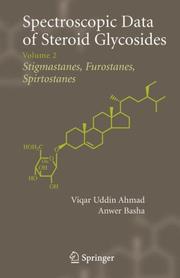
ISBN: 9780387395722 0387311602 9780387311609 1441940561 9786612923814 0387395725 1282923811 Year: 2006 Publisher: New York, NY : Springer US : Imprint: Springer,
Abstract | Keywords | Export | Availability | Bookmark
 Loading...
Loading...Choose an application
- Reference Manager
- EndNote
- RefWorks (Direct export to RefWorks)
Spectroscopic Data of Steroid Glycosides Dr. Viqar Uddin Ahmad, HEJ Research Institute of Chemistry, University of Karachi, Karachi, Pakistan Dr. Anwer Basha, Abbott Laboratories , Abbott Park, Illinois, USA Spectroscopic Data of Steroid Glycosides serves as an essential reference guide containing spectroscopic, physical and biological activity data of over 3500 steroid glycosides, offering the structures and the data of the naturally occurring glycosides of steroids. All compounds are arranged according to the structure of the aglycone, and, in its own class, according to the increasing molecular weight, making Spectroscopic Data of Steroid Glycosides extremely useful for the structure elucidation of new natural products, particularly glycosides. Spectroscopic Data of Steroid Glycosides offers a practical desk reference for all scientists and students interested in steroid glycosides and their biological and medicinal importance. The following data of the steroid glycosides, as available in published literature, are included: Name of the compound Chemical name of compound and its structure Source, name of the genus, species, authors, family of the biological source from which the glycoside has been isolated. Melting point Specific rotation Molecule weight Molecular formula UV spectral data : maxima, e or log e , solvent IR peaks in cm-1 with medium in which the spectrum was taken e.g. KBr, nujol, etc Proton magnetic resonance (PMR) chemical shifts, multiplicity of the peaks, coupling constants with assignments 13C-NMR (CMR) chemical shifts with assignments Mass spectral data with the technique used (e.g. Electron Impact (E.I.), Fast Atom Bombardment (FAB), positive ion or negative ion mode or any other technique CD or ORD data Biological Activity Full reference from which data have been taken.
Life Sciences. --- Biochemistry, general. --- Pharmacology/Toxicology. --- Medical Biochemistry. --- Plant Biochemistry. --- Agriculture. --- Life sciences. --- Toxicology. --- Biochemistry. --- Sciences de la vie --- Toxicologie --- Biochimie --- Agriculture --- Glycosides -- Chemistry. --- Magnetic Resonance Spectroscopy -- Statistics & numerical data. --- Molecular structure. --- Saponins -- Chemistry. --- Spectrum analysis. --- Steroid glycosides. --- Steroids -- Chemistry. --- Chemistry --- Human Anatomy & Physiology --- Biology --- Health & Biological Sciences --- Physical Sciences & Mathematics --- Biochemistry --- Animal Biochemistry --- Biology - General --- Steroid glycosides --- Spectra. --- Pharmacology. --- Medical biochemistry. --- Plant biochemistry. --- Glycosides --- Steroids --- Steroid saponins --- Farming --- Husbandry --- Industrial arts --- Life sciences --- Food supply --- Land use, Rural --- Chemicals --- Medicine --- Pharmacology --- Poisoning --- Poisons --- Biological chemistry --- Chemical composition of organisms --- Organisms --- Physiological chemistry --- Medical sciences --- Toxicology --- Composition --- Phytochemistry --- Plant biochemistry --- Plant chemistry --- Botany --- Phytochemicals --- Plant biochemical genetics --- Medical biochemistry --- Pathobiochemistry --- Pathological biochemistry --- Pathology --- Drug effects --- Medical pharmacology --- Chemotherapy --- Drugs --- Pharmacy --- Physiological effect
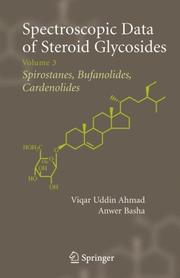
ISBN: 9780387395746 0387311610 9780387311616 9786613250575 0387395741 1283250578 148999713X Year: 2007 Publisher: New York, NY : Springer US : Imprint: Springer,
Abstract | Keywords | Export | Availability | Bookmark
 Loading...
Loading...Choose an application
- Reference Manager
- EndNote
- RefWorks (Direct export to RefWorks)
Spectroscopic Data of Steroid Glycosides Dr. Viqar Uddin Ahmad, HEJ Research Institute of Chemistry, University of Karachi, Karachi, Pakistan Dr. Anwer Basha, Abbott Laboratories , Abbott Park, Illinois, USA Spectroscopic Data of Steroid Glycosides serves as an essential reference guide containing spectroscopic, physical and biological activity data of over 3500 steroid glycosides, offering the structures and the data of the naturally occurring glycosides of steroids. All compounds are arranged according to the structure of the aglycone, and, in its own class, according to the increasing molecular weight, making Spectroscopic Data of Steroid Glycosides extremely useful for the structure elucidation of new natural products, particularly glycosides. Spectroscopic Data of Steroid Glycosides offers a practical desk reference for all scientists and students interested in steroid glycosides and their biological and medicinal importance. The following data of the steroid glycosides, as available in published literature, are included: Name of the compound Chemical name of compound and its structure Source, name of the genus, species, authors, family of the biological source from which the glycoside has been isolated. Melting point Specific rotation Molecule weight Molecular formula UV spectral data : maxima, e or log e , solvent IR peaks in cm-1 with medium in which the spectrum was taken e.g. KBr, nujol, etc Proton magnetic resonance (PMR) chemical shifts, multiplicity of the peaks, coupling constants with assignments 13C-NMR (CMR) chemical shifts with assignments Mass spectral data with the technique used (e.g. Electron Impact (E.I.), Fast Atom Bombardment (FAB), positive ion or negative ion mode or any other technique CD or ORD data Biological Activity Full reference from which data have been taken.
Life Sciences. --- Biochemistry, general. --- Pharmacology/Toxicology. --- Medical Biochemistry. --- Plant Biochemistry. --- Agriculture. --- Life sciences. --- Toxicology. --- Biochemistry. --- Sciences de la vie --- Toxicologie --- Biochimie --- Agriculture --- Glycosides -- chemistry. --- Glycosides. --- Magnetic Resonance Spectroscopy -- statistics & numerical data. --- Molecular Structure. --- Pharmaceutical chemistry -- Technique. --- Saponins -- chemistry. --- Spectrum analysis. --- Steroid glycosides. --- Steroids -- Analysis. --- Steroids -- chemistry. --- Steroids -- Structure. --- Human Anatomy & Physiology --- Chemistry --- Biology --- Health & Biological Sciences --- Physical Sciences & Mathematics --- Animal Biochemistry --- Biochemistry --- Biology - General --- Pharmacology. --- Medical biochemistry. --- Plant biochemistry. --- Chemicals --- Medicine --- Pharmacology --- Poisoning --- Poisons --- Biological chemistry --- Chemical composition of organisms --- Organisms --- Physiological chemistry --- Medical sciences --- Farming --- Husbandry --- Industrial arts --- Life sciences --- Food supply --- Land use, Rural --- Toxicology --- Composition --- Phytochemistry --- Plant biochemistry --- Plant chemistry --- Botany --- Phytochemicals --- Plant biochemical genetics --- Medical biochemistry --- Pathobiochemistry --- Pathological biochemistry --- Pathology --- Drug effects --- Medical pharmacology --- Chemotherapy --- Drugs --- Pharmacy --- Physiological effect
| Listing 1 - 10 of 14 | << page >> |
Sort by
|

 Search
Search Feedback
Feedback About
About Help
Help News
News